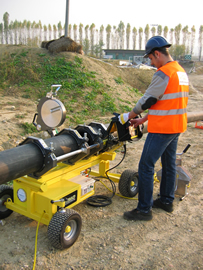HDPE
HDPE pipe offers many advantages to other piping systems used throughout the world.
HDPE pipe is lighter than traditional piping materials and is corrosion resistant, which results in substantial savings for the owners and the customers. The pipe is flexible (not rigid) and can then be produced in coils and straight lengths. Since HDPE is a flexible (not rigid) and ductile (not brittle) material, the pipe resists earthquake, surge (water hammer) and fatigue loads and can easily be installed with bends and over uneven terrain in continuous lengths without additional welds or couplings.
Polyethylene pipe utilizes heat fusion methods such as butt fusion, socket fusion, sidewall fusion, and electrofusion to join the material, which creates a joining system stronger than the pipe itself. HDPE fusion methods create a leak proof, fully restrained joint, which represents the best solution for trench-less installations.
Significant cost savings can be realized compared to traditional piping materials: Real savings in product costs, installation efficiency, life cycle costs, durability and long-term life expectancy are major advantages of HDPE piping systems.
The properties of the HDPE material make the pipe extremely resistant to scale build up that otherwise leads to decreased flow rates. The exceptionally smooth surface of polyethylene pipe offers minimal resistance to flow and the flow remains relatively constant for the life of the pipe, unlike other piping products that must allow for a reduction of flow capacity over time.
